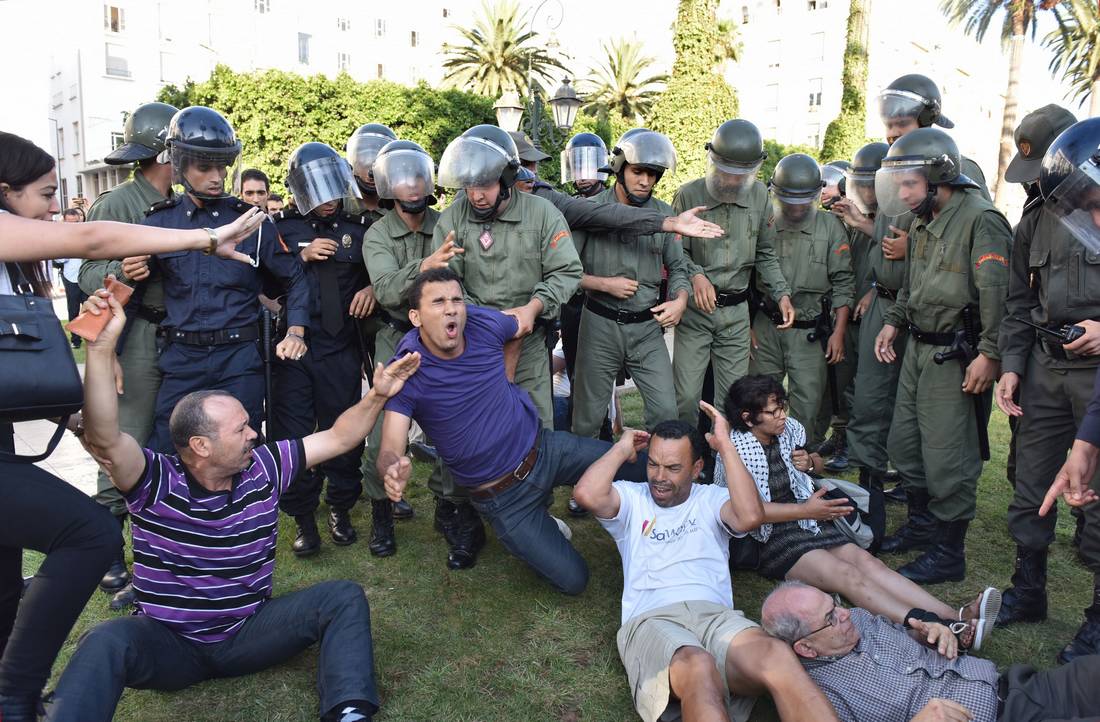الرباط (CNN)— عشية كل تدخل أمني لتفريق احتجاجات أو مظاهرات بالمغرب، يتجدد النقاش حول القانون المنظم لأشكال الاحتجاج في الأماكن العمومية، إذ غالبا ما تقدم السلطات المحلية الظهير الشريف رقم 1.58.377، بشأن التجمعات العمومية الصادر في 15 نونبر من سنة 1958 (عدل مرتين آخرها عام 2002)، كنص قانوني يشرعن عملية التدخل، بينما يعتبر الحقوقيون في كثير من المرات أن القوات العمومية تتدخل خارج إطار القانون.
وكمثال على النقاش القديم-الجديد، فالوقفة التي نظمتها فعاليات حقوقية يوم السبت الماضي، انتهت بتدخل أمني خلّف إصابات بين المحتجين ونقل عدد منهم للمستشفى، الأمر الذي أثار غضبا حقوقيا كبيرا، فيما ردت السلطات المحلية أن التجمهر لم يكن مرخصا، وأنه جرى تنبيه المحتجين بذلك لكنهم تشبتوا بالبقاء، كما اتهمت عددا منهم بالتظاهر بالإغماء.
وعودة إلى الظهير المذكور، فهو ينصّ على ضرورة أخذ تصريح سابق لجميع المظاهرات بالطرق العمومية، كما يمنع كل تجمهر مسلح، وكل تجمهر غير مسلح من شأنه أن يخلّ بالأمن العمومي، ويحدد القانون ضرورة استخدام مكبر صوت، قبل التدخل، لتبليغ المتجمهرين بضرورة الانصراف ثلاث مرات، مع ذكر العقوبات التي قد تصل إلى شهرين اثنين في حالة التجمهرات غير المسلحة إذا وقع تشتيتها بالقوة.
ويضمن الفصل 29 من الدستور المغربي التجمهر السلمي، كما ينص الفصل 22 منه على "عدم جواز المس بالسلامة الجسدية أو المعنوية لأي شخص، في أي ظرف، ومن قبل أي جهة كانت، خاصة أو عامة"، مما يثير نقاشا واسعا حول الظهير والتدخل الأمني وعلاقة ذلك بما يضمنه الدستور المغربي.
هل يجب تعديل الظهير من جديد؟
ويرى أمين السعيد، باحث في العلوم السياسية والقانون الدستوري، إن السلطات التشريعية ملزمة بإعادة النظر في تعديل هذا النص القانوني قصد "ملاءمته مع فصول دستور 2011 التي أضحت تتيح هامشا واسعا من الحريات والحقوق الفردية"، مبرزا لـCNN بالعربية أن هذا الظهير في حاجة إلى "نفس ديمقراطي لمواكبة الاجتهادات القضائية والتوجهات والاتفاقيات الدولية المؤطرة للتجمعات العمومية خاصة العهد الدولي للحقوق المدنية والسياسية".
غير أن عبد العلي حامي الدين، رئيس منتدى الكرامة لحقوق الإنسان، يرى أن النص لا يحتاج تعديلا، بل المشكل في "طريقة تطبيقه"، متحدثا لـCNN عن أن فلسفة هذا الظهير جاءت لمنع أشكال التجمع التي تعرقل السير العمومي، عكس الوقفات الاحتجاجية في الأماكن القارة التي لا تسبّب أي عرقلة، لافتا إلى وجود حكم إداري يؤكد أن هذه الوقفات لا تحتاج إلى ترخيص مسبق، بل مجرّد إشعار يبلغ بأيّ وسيلة كانت.
كيف يتم تطبيق الظهير؟
يتحدث أمين السعيد عن أن السلطات المحلية تتعامل مع هذا الظهير وفق مقاربة هامش الربح والخسارة حسب قوله، فـ"تارة تتغاضى عن فض التجمعات، وتارة أخرى تمنعها وتفضها بمقاربة أمنية صارمة، وتارة تتجاوب معها وتبرر الإنزال الأمني بحماية المتظاهرين"، وهو الأمر الذي يجعل المنظمات الحقوقية تصف تعامل الدولة مع المتجمهرين، بـ"التعامل المزاجي وغير المفهوم"، مبرزا أن السلطات مطالبة بـ"حكامة أمنية تحترم المقتضيات الدستورية والقانونية المتعلقة بفض التجمهر".
حول هذا المعطى، يقول حامي الدين إن تفريق عدد من الوقفات الاحتجاجية يأتي بتعليمات لديها خلفية سياسية، متحدثا عن أن هناك "من يريد تأزيم الأوضاع خلال تفريق الاحتجاجات بشكل يقوّض فرص التهدئة، خاصة وأنه لا يجب الركل والصفع واستخدام العصي في التفريق مادامت هناك وسائل أخرى لا تلحق الأذى بالمحتجين كخراطيم المياه"، مبرزا أن " تنفيذ القانون يوجد فيه تعسف، وأن الحكامة الأمنية تغيب خلال التعامل مع عدد من الاحتجاجات".
